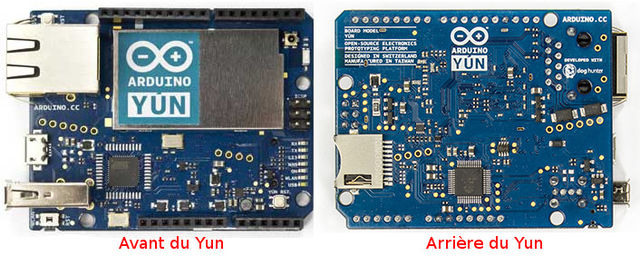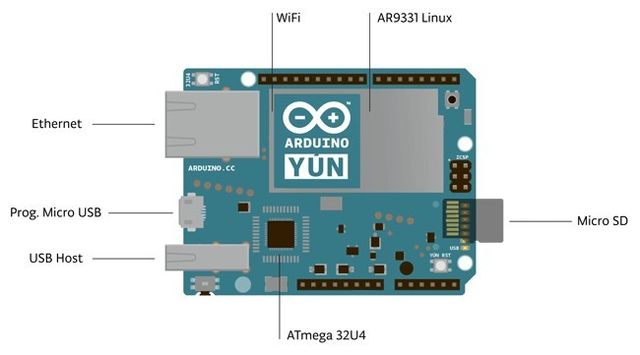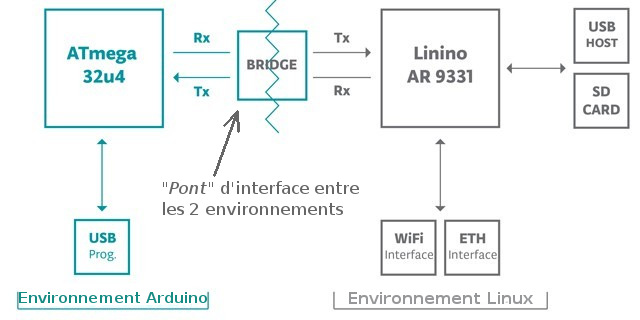Différences entre versions de « Arduino Yun-Présentation »
(→Aperçu) |
(→Aperçu) |
||
| Ligne 15 : | Ligne 15 : | ||
The Yún is similar to the Leonardo in that the ATmega32u4 has built-in USB communication, eliminating the need for a secondary processor. This allows the Yún to appear to a connected computer as a mouse and keyboard, in addition to a virtual (CDC) serial / COM port. | The Yún is similar to the Leonardo in that the ATmega32u4 has built-in USB communication, eliminating the need for a secondary processor. This allows the Yún to appear to a connected computer as a mouse and keyboard, in addition to a virtual (CDC) serial / COM port. | ||
| − | {{ARDImage|Arduino-Yun-Pres03.jpg|640px}}<small>Traduction par MCHobby.be</small> | + | {{ARDImage|Arduino-Yun-Pres03.jpg|640px}}<small> Traduction par MCHobby.be</small> |
The Bridge library facilitates communication between the two processors, giving Arduino sketches the ability to run shell scripts, communicate with network interfaces, and receive information from the AR9331 processor. The USB host, network interfaces and SD card are not connected to the 32U4, but the AR9331, and the Bridge library also enables the Arduino to interface with those peripherals. | The Bridge library facilitates communication between the two processors, giving Arduino sketches the ability to run shell scripts, communicate with network interfaces, and receive information from the AR9331 processor. The USB host, network interfaces and SD card are not connected to the 32U4, but the AR9331, and the Bridge library also enables the Arduino to interface with those peripherals. | ||
Version du 14 octobre 2013 à 12:59
Aperçu

Crédit: Arduino arduino.cc
The Arduino Yún is a microcontroller board based on the ATmega32u4 (datasheet) and the Atheros AR9331. The Atheros processor supports a Linux distribution based on OpenWRT named Linino. The board has built-in Ethernet and WiFi support, a USB-A port, micro-SD card slot, 20 digital input/output pins (of which 7 can be used as PWM outputs and 12 as analog inputs), a 16 MHz crystal oscillator, a micro USB connection, an ICSP header, and a 3 reset buttons.
NB : In some countries, it is prohibited to sell WiFi enabled devices without government approval. While waiting for proper certification, some local distributors are disabling WiFi functionality. Check with your dealer before purchasing a Yún if you believe you may live in such a country. If you wish to disable WiFi, run ce sketch/croquis]. For more information, refer to this forum post.

Crédit: Arduino arduino.cc
The Yún distinguishes itself from other Arduino boards in that it can communicate with the Linux distribution onboard, offering a powerful networked computer with the ease of Arduino. In addition to Linux commands like cURL, you can write your own shell and python scripts for robust interactions.
The Yún is similar to the Leonardo in that the ATmega32u4 has built-in USB communication, eliminating the need for a secondary processor. This allows the Yún to appear to a connected computer as a mouse and keyboard, in addition to a virtual (CDC) serial / COM port.

Crédit: Arduino arduino.cc Traduction par MCHobby.be
The Bridge library facilitates communication between the two processors, giving Arduino sketches the ability to run shell scripts, communicate with network interfaces, and receive information from the AR9331 processor. The USB host, network interfaces and SD card are not connected to the 32U4, but the AR9331, and the Bridge library also enables the Arduino to interface with those peripherals.
Détails techniques
Arduino
- Microcontrolleur: ATmega32u4
- Tension de fonctionnement: 5V
- Tension d'entrée (recommandée): 5V via microUSB ou PoE 802.3af
- Tension d'entrée (limites): 6-20V
- Entrée/sortie digital: 14
- PWM: 7 canaux
- Entrées analogiques: 6 (plus 6 multiplexées sur 6 broches digitals)
- Courant continu par entrée/sortie: 40 mA
- Courant continu pour broche 3.3V: 50 mA
- Mémoire Flash: 32 KB (ATmega32u4) dont 4 KB utilisé par le bootloader
- SRAM: 2.5 KB (ATmega32u4)
- EEPROM: 1 KB (ATmega32u4)
- Vitesse d'horloge: 16 MHz
Machine Linux embarquée
- Processeur MIPS 24K fonctionnant jusqu'à 400 MHz
- RAM: 64MB DDR2 (et Flash de 16MB SPI)
- IEEE 802.11bgn complet 1x1 AP ou routeur
- WIFI
- Connexion Ethernet
- USB: USB 2.0 host/device
- Compatibe Power Over Ethernet (poE) 802.3af
- Support carte MicroSD
Source: Arduino Yun, Guide to the Arduino Yún. Crédit: Arduino.cc, licence Creative Common Attribution ShareAlike.
Toute référence, mention ou extrait de cette traduction doit être explicitement accompagné du texte suivant : « Traduction par MCHobby (www.MCHobby.be) - Vente de kit et composants » avec un lien vers la source (donc cette page) et ce quelque soit le média utilisé.
L'utilisation commercial de la traduction (texte) et/ou réalisation, même partielle, pourrait être soumis à redevance. Dans tous les cas de figures, vous devez également obtenir l'accord du(des) détenteur initial des droits. Celui de MC Hobby s'arrêtant au travail de traduction proprement dit.